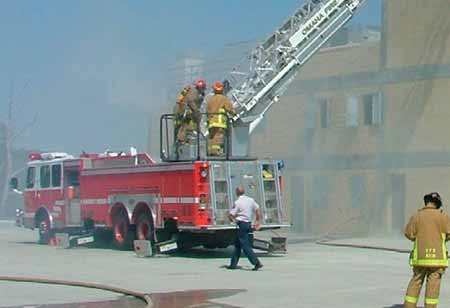Thank you for Subscribing to Gov Business Review Weekly Brief
Scaling New Heights: The Evolution and Impact of Firefighter Training Towers
Firefighter training towers are critical structures in the comprehensive training and development of firefighters.

By
Gov Business Review | Tuesday, August 20, 2024
Stay ahead of the industry with exclusive feature stories on the top companies, expert insights and the latest news delivered straight to your inbox. Subscribe today.
Firefighter training towers are critical structures in the comprehensive training and development of firefighters. These towers are specially designed facilities that simulate various fire scenarios and emergency situations, providing firefighters with the necessary experience and skills to handle real-life emergencies effectively. The significance of these towers in firefighter training cannot be overstated, as they play a pivotal role in ensuring the safety, preparedness, and competence of firefighting personnel.
Firefighting is an inherently dangerous profession that requires a unique set of skills, physical conditioning, and mental fortitude. Firefighters must be able to quickly assess situations, make informed decisions under pressure, and execute complex maneuvers to save lives and protect property. Training towers are designed to replicate the diverse and challenging environments that firefighters may encounter in the line of duty. By providing a controlled and safe environment for training, these towers allow firefighters to gain hands-on experience and build confidence in their abilities.
One of the primary features of firefighter training towers is their ability to simulate different types of fires and emergency scenarios. These structures are typically multi-story buildings that can be configured to mimic residential, commercial, and industrial settings. Training towers are equipped with various elements such as stairwells, hallways, windows, and confined spaces, all of which are designed to challenge firefighters and enhance their tactical skills. In addition, some towers are equipped with live fire props, which allow trainees to practice fire suppression techniques in a controlled environment. These props can simulate everything from kitchen fires to flammable liquid spills, providing a realistic and varied training experience.
The use of live fire in training towers is a crucial aspect of firefighter training. Fire behavior is complex and can be influenced by numerous factors such as building materials, ventilation, and the presence of flammable substances. Training towers allow firefighters to observe and understand how fires behave in different conditions, which is essential for developing effective fire suppression strategies. Live fire training also helps firefighters become accustomed to the heat, smoke, and reduced visibility that they will encounter in real fires. This experience is invaluable in helping them maintain their composure and effectiveness in high-pressure situations.
In addition to fire suppression, training towers are used to teach and practice a wide range of firefighting skills. These include search and rescue operations, ventilation techniques, ladder placement and usage, and the deployment of hoselines. Search and rescue training is particularly important, as firefighters often need to locate and rescue victims from burning buildings. Training towers can be set up with smoke machines and dummy victims to create realistic search and rescue scenarios. This allows firefighters to practice their techniques and improve their ability to navigate through smoke-filled environments.
Ventilation is another critical skill that is taught in training towers. Proper ventilation can significantly improve visibility and reduce the risk of flashover, a dangerous phenomenon where a room suddenly erupts into flames. Training towers are designed with various roof and wall configurations that allow firefighters to practice ventilation techniques such as roof cutting and window breaking. These exercises help firefighters understand the best methods for venting smoke and heat from a building, enhancing their overall effectiveness in fire suppression operations.
Ladder training is also an essential component of firefighter training. Training towers provide a controlled environment for practicing ladder placement, climbing, and victim rescues from elevated positions. This is crucial for developing the physical coordination and strength required for ladder operations.
Additionally, training towers are often equipped with anchor points and rappelling equipment, allowing firefighters to practice rope rescue techniques. These skills are vital for rescuing individuals from high-rise buildings or other challenging environments.
The use of training towers is not limited to new recruits; experienced firefighters also benefit from ongoing training in these facilities. Continuous training is essential for maintaining and updating skills, as well as for staying current with new techniques and technologies. Firefighters must regularly practice their skills to ensure they are prepared for any situation they may encounter. Training towers provide a versatile and realistic environment for this ongoing training, allowing firefighters to continually hone their abilities.
Moreover, training towers serve as valuable tools for evaluating and improving firefighting strategies and procedures. Fire departments can use these facilities to test new equipment, tactics, and protocols in a controlled setting before deploying them in the field. This helps ensure that any new methods are effective and safe. Training exercises conducted in towers can also be used to identify areas where firefighters may need additional training or support, leading to more targeted and effective training programs.
The design and construction of firefighter training towers are critical to their effectiveness. These structures must be robust and durable to withstand the rigors of repeated training exercises. They are typically constructed from materials such as concrete and steel, which can endure high temperatures and physical stress. The interior of the towers is designed to be modular and flexible, allowing for different configurations and scenarios. This adaptability is essential for providing a varied and comprehensive training experience.
Safety is a paramount concern in firefighter training, and training towers are designed with numerous safety features to protect trainees. These features include fire-resistant materials, ventilation systems to remove smoke, and emergency escape routes. Instructors closely monitor training exercises to ensure that safety protocols are followed and to provide immediate assistance if needed. The controlled environment of training towers allows for realistic training while minimizing the risk of injury.
More in News






